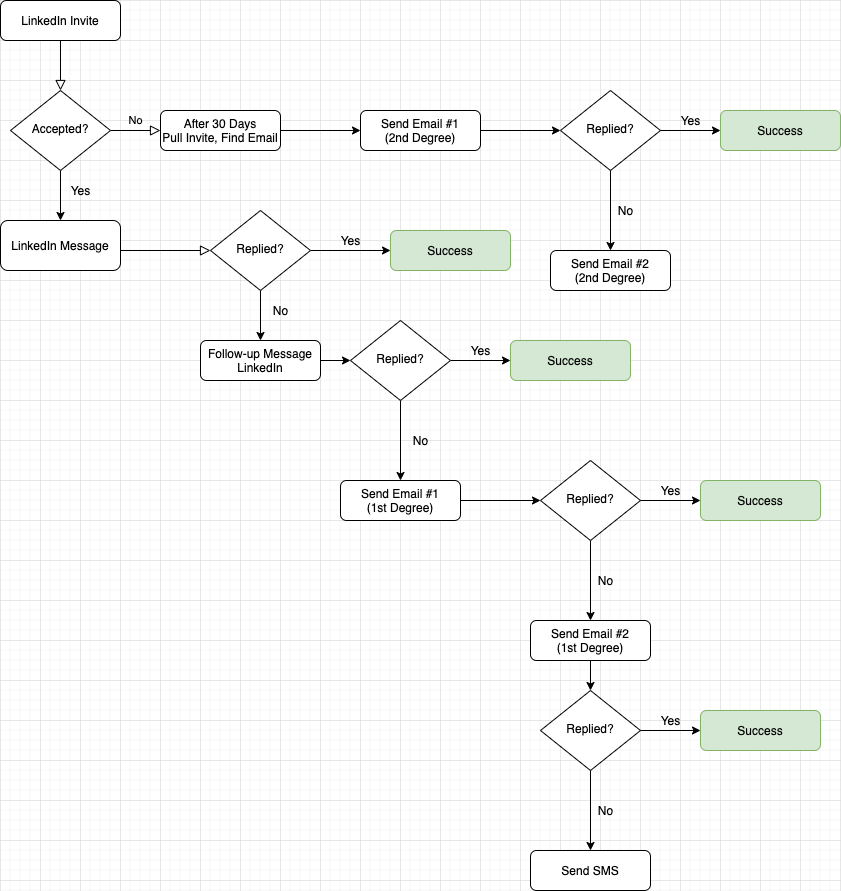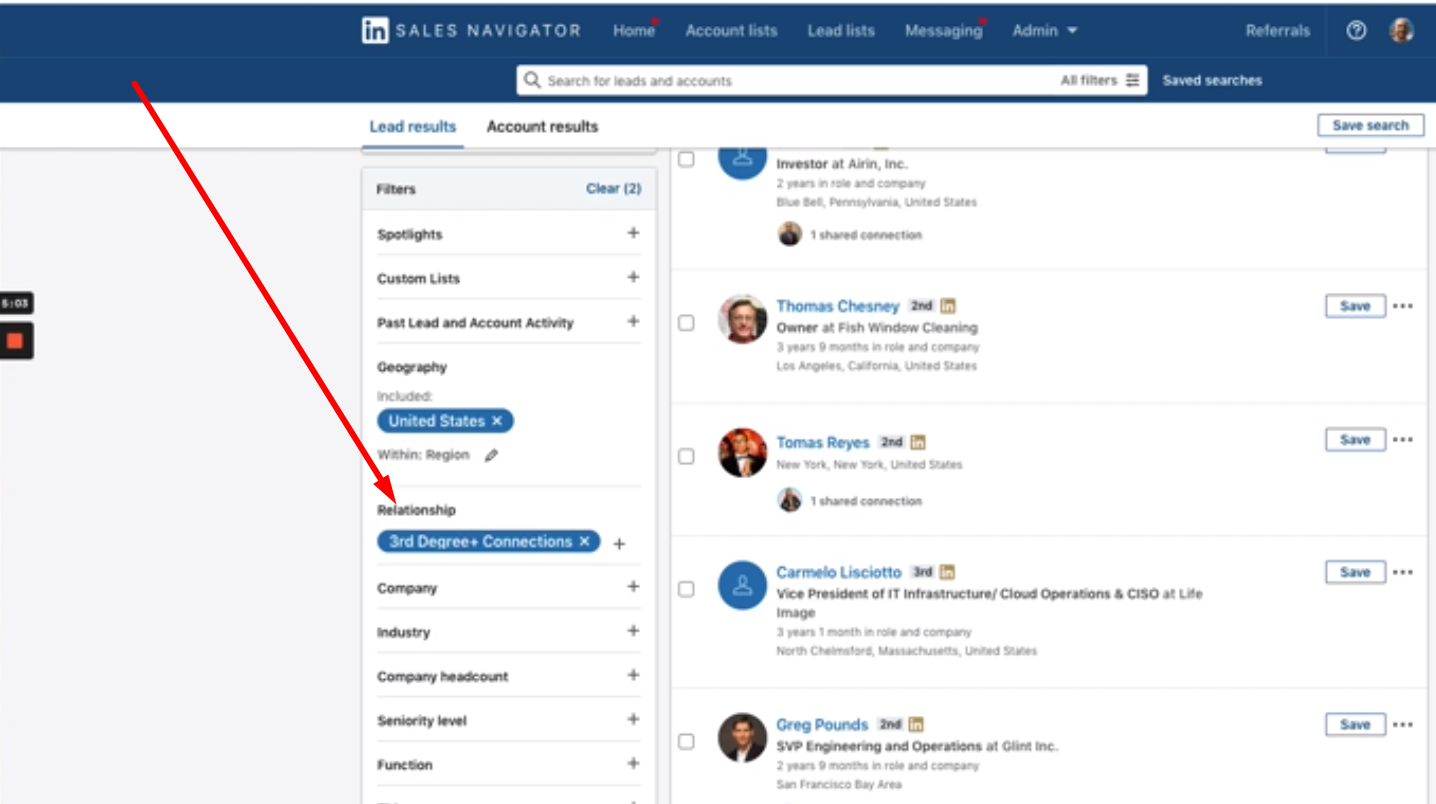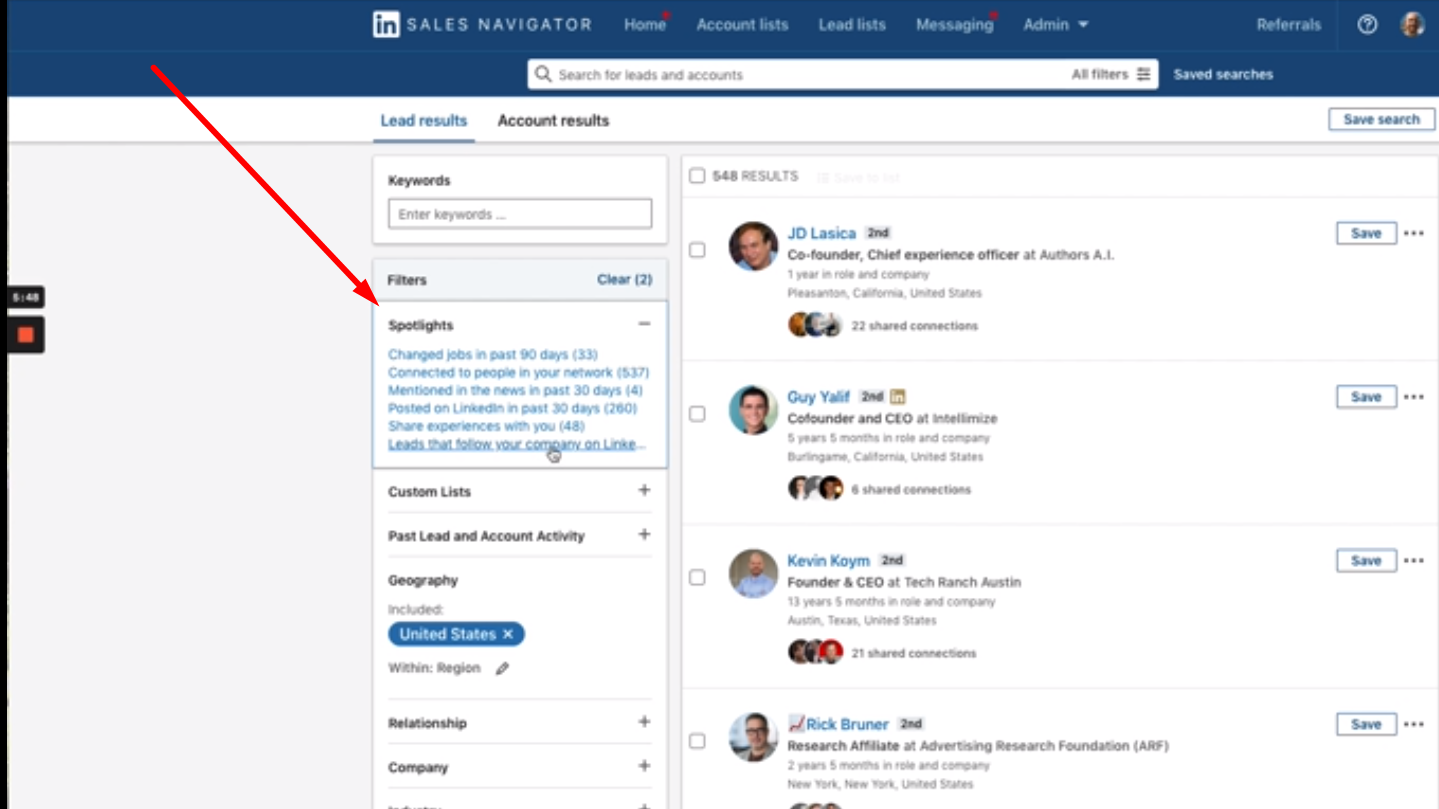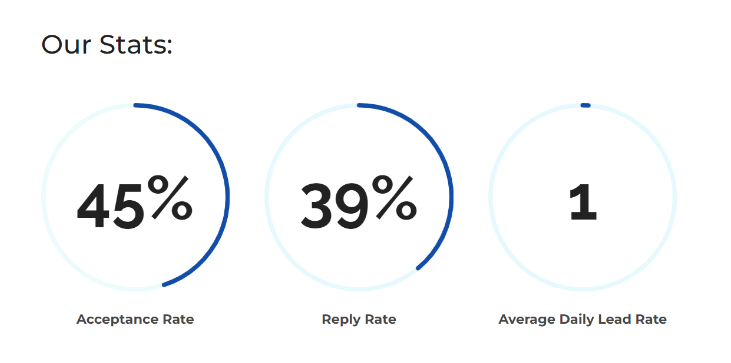
Many people ask: “Hey, Jack, how do you manage to get 1 lead a day?”
The short answer is:
“Use email + LinkedIn, good copywriting, and add lots of personalization to generate leads.”
But if you’re interested in learning our exact strategy for 1 lead a day, read on.
Our outbound sales strategy isn’t complex.
It just takes time, follow-ups, and knowing what people are replying to these days.
Thankfully, with over a decade of experience, we were able to develop and grow a strategy that works.
(Hint: This strategy starts sales conversations, and this in turn leads to phone calls and booked meetings. )
So if cold outreach isn’t working for you, try this approach first, along with the other strategies that we will mention in this article.
(With our LinkedIn lead generation strategy, we have generated close to 7000 qualified sales leads for our clients within the past 24 months. If you’re interested in learning how to apply this strategy to your own business, hop on a free 15-minute strategy session with the founder of SalesBread, Jack Reamer.)
1. LinkedIn Lead Generation
Here is how we do it
(Remember to first build an ultra-targeted list of your ideal customer profile. You can read more about list building in this article:
How to Build a Sales Prospecting List in Any Industry. If your list isn’t perfect and super refined, you aren’t going to get qualified sales leads.)

Step 1: It all starts with a LinkedIn Connection invite.
Ideally, you would want to connect with those in your second-degree network.
(If you would like some connection request invite templates for inspiration, read this article .)
Why?
Well, think of it this way: you want to send invites out to potential clients who are actually engaged on LinkedIn.
Those who are active on this platform.
This is because if you send the invites to people who aren’t really using LinkedIn, you won’t get many people accepting your invites.
But…
You might be asking, “How do you know who is actually using LinkedIn and who isn’t?”
Well, there are 2 ways in which you can tell.
Number 1:
They already share a common connection with you, meaning they are already in your second-degree network.
What does this tell you?
Well, it tells you that they have already accepted people like you in the past.
It also tells you that they have a certain network size and that there is someone behind the LinkedIn profile who is likely to accept people who are relevant to them.
Number 2:
You can also connect with those who are outside of your second-degree network, but it’s important to check that they have recently posted something within the past 30 days.
Want to know how to do this?
Just pop into Sales Navigator, add in your search criteria by the filter section and type in 3rd degree.
You can then go to the “Spotlight” section and click “Posted on LinkedIn within the past 30 days.”
This will bring up people in your 3rd-degree connection who have been active on LinkedIn within the past month. ( See screenshots below:)



Step 2: What happens once that invite gets accepted? – Reply with more personalization…
Great! They accepted your LinkedIn connection request.
Now what?
This is where you are going to follow up by sending them an ultra-personalized message.
(At SalesBread, we actually have a personalization expert SDR, whose only job is to actually research each prospect on the list and find something very specific to write about them in our messages.)
It is crucial that you add a custom intro sentence that compliments them on something they’ve shared.
You could say something like this:
“ By the way, I loved your webinar on {{topic}}; I would like to attend more.”
OR
“I see that you enjoy hiking. Where are the best hiking spots lately?”
You could also mention something that you both share in common, or you could ask a question about something interesting that they posted.
This outbound sales tactic allows for a “pattern interrupt,” which makes the prospect think, “Wait a minute, this isn’t just a spammer, but an actual person who is interested in me.”
This makes it more likely that they will reply to you.
Remember the 90/10 rule.
ALWAYS talk about the prospect 90% of the time and only 10% about yourself for context.
Another important factor when it comes to personalized messages is not to jump into your sales pitch immediately. This will put your target audience off any further conversations with you.
(Think about a cold call you received recently… Probably weren’t too happy with the sales rep trying to sell you insurance.)
Remember to keep it friendly.
Discuss the prospect’s pain points and how you think you could help each other in business.
Pro Tip:
Do not be like pushy salespeople. (No one enjoys being pushed into sales calls that they don’t want.)
If you are pushy, this will get your qualifying customer to cut the conversation within a matter of seconds, ending your lead generation sales cycle.
Step 3: Use a low-commitment CTA
We always send between 2-6 follow-up messages.
An important thing to remember is to also always ask for a meeting or a call in these messages.
Here are some ways to ask for a meeting :
- Are you available for a chat?
- How is your availability for a 10-minute call this week?
- I’d love to share more on why you may need [PRODUCT] and how it can help [BENEFIT]. How’s {{=day}} next week look for a 15-minute call?
- Are you free for a call this Friday to discuss [MAIN BENEFIT]?
- Are you available for a quick call in the next days to see if [MY PRODUCT] aligns with your goals?
- Send me your calendar link, and I will book a spot.
What happens if the prospect does not accept the invite?
If they have not accepted the connection request after 21 – 30 days, withdraw the invitation from LinkedIn.
The reason?
This ensures that the prospect does not accumulate hundreds of pending LinkedIn invites.
You can also send them a cold email during the sales campaign if they are in your second-degree network.
In the email, make sure that your marketers also use personalization and mention a common connection that they share. Hopefully, this will get a reply.
You can even mention you sent them an invite on LinkedIn as a PS.
But even with email messaging, we will always send them a custom intro sentence (a real-time message, not some random automation) with a lot of personalization throughout.
This will help the reader realize that this email isn’t just some random spam mail.
This is an outbound sales process that we have used over the years, and it has always gotten us good reply rates and high-quality leads.
Take a look at some of our most recent outbound sales metrics for LinkedIn :
You can read more about LinkedIn outreach stats here.

What happens if they don’t reply?
If the prospect hasn’t replied after two follow-up messages on LinkedIn, we will send them an email.
Where do we find their email address?
Well, most of the time, we will find it on their LinkedIn profile, or you could use a data provider, such as Apollo.io.
If they reply to the email, that’s a success, and hopefully, they will agree to a meeting.

What if they don’t reply to the email?
If they haven’t replied to the email, you can then send an SMS.
Where do we get their phone number from?
A phone number might be provided on the prospect’s LinkedIn profile if they share it with their first-degree connections.
The fact that they provided their contact information on their profile means that there is a good chance that they don’t mind hearing about work-related things from their first connections.
What if they still don’t reply even after an email and an SMS?
We will still send up to 5 follow-up cold emails and SMS messages.
Is this an effective outbound sales strategy?
Well, you tell us.
Here are some replies that we have received from using this approach on LinkedIn :
If you’re interested, check out some of our case studies that also go into detail on how we generated 20+ qualified leads a month for our clients. Whether they are in the SaaS space, startups, or even Fortune 500 companies.
2. Email Outreach in the Outbound Sales Process
Why Email Outreach Matters in the Sales Cycle
Email outreach is one of the most cost-effective outbound sales techniques that you can use. It allows sales reps to contact a number of potential buyers with personalized messages for their ideal buyer persona.
A well strategized cold email outreach campaign can nurture business relationships and increase conversion rates, especially in b2b sales, if done correctly.
Effective Strategies for Email Outreach
For a successful outbound sales approach for email, you need to follow a similar strategy to our LinkedIn method above. You can also use sales automation tools like QuickMail to warm up your inbox.
This will ensure that you get a good sender reputation.
Email marketing also keeps your business at the top of the minds of your prospects. If you had to send a helpful email once a week with a strong CTA, it could move your prospects to reach out to you.
If you show yourself as a leader in your field, people will be more inclined to contact you.
3. Cold Calling as an Outbound Sales Technique
Cold calling is still one of the most direct ways for outbound sales reps to reach potential buyers.
Cold calling isn’t as effective as other outbound methods. Although it’s often seen as outdated, when done right, like for example, calling prospects who have already been qualified, can still be an effective outbound prospecting method.
Just make sure that you build a really targeted list first and use some personalization based on research.
For example, if you know that this individual really needs what you’re selling, you could mention their pain points and how your product can solve them.
Before you start this particular outbound process, make sure that cold calling is legal in your country.
Sales Tools and Techniques to Improve Cold Calling
Use modern outbound sales tools like CRM integrations and AI dialers to streamline your outbound sales efforts. You would also need to train sales representatives to open with value-based intros and qualify leads quickly.
This will help maintain a healthy sales pipeline and shorten the sales cycle.
Is Cold Calling Still an Effective Outbound Sales Strategy?
For some industries, yes. We have seen that those in the construction industry are particularly phone heavy, whereas those in tech would rather receive an email or a LinkedIn message.
4. SMS Outreach and the Short Sales Process
SMS Outreach for reaching out to Ideal Customers
SMS outreach is a great step to add to your outbound methods.
Previously, we would reach out to our prospects who didn’t respond to LinkedIn or email via SMS.
In order to check if this method will work, see if they have shared their cell phone number on their social media profiles.
Some people are happy to share their numbers for business, but if you can’t find their phone numbers easily online, it probably means they don’t want to be contacted via a phone step.
If this is the case, rather use LinkedIn or email to book a call with the prospect. You could then get permission to use SMS as a sales team to follow up on leads quickly or confirm appointments.
5. Referral Campaigns in Business Development
Using Referral Marketing in the Outbound Process
Referral marketing helps you build existing business relationships to bring in new leads. For example
This method shortens the sales cycle by building trust quickly and ensuring alignment with your buyer persona.
How Referral Campaigns Work (and How to Use Them for Outbound)
Referral campaigns are basically about getting people who are already happy with your product to tell others about it. It’s word of mouth, but with a little structure, and sometimes a reward to sweeten the deal.
Usually, it works like this:
Someone refers a friend.
That friend signs up or buys something. Then the person who made the referral gets something in return, maybe a discount, a gift card, or just a “Thank You”.
Sometimes the new customer gets a reward too, which makes it feel less one sided.
Using Referrals as an Outbound Strategy
Even though referral programs are often treated like something you just set up and hope people use, you can actually use them actively, as part of your outreach.
Here’s how:
Reach out to your happy paying customers
Start by contacting your happy customers or people you’ve worked with before. Let them know you’ve got a referral program and that you’d love their help spreading the word. Make it easy for them and give them a short message they can forward, or a unique link they can share.
It doesn’t have to feel salesy. Just a friendly, “Hey, if you know anyone who might need this, feel free to send them my way. I’ll make it worth your while.”
Add Referrals to Cold Outreach
If you’re doing cold emails or DMs, you can include a quick line about referrals. Something like:
“Even if this isn’t a fit for you, maybe you know someone it might help. I’ve got a little referral bonus if you send them my way.”
That way, the person doesn’t feel like it’s a waste of their time, even if they’re not interested themselves, they might know someone who is.
Use Simple Tools to Track It
There are plenty of tools that help you keep track of referrals, for example, who sent who, who gets what, etc. But even if you’re just starting, a spreadsheet and referrer details can work too. The important thing is to make sure people get credit when they bring someone in.
6. Billboards as an Outbound Selling Strategy

Women’s Aid: Look at me campaign (Courtesy of BoardPanda)
How Billboards Can Help with Outbound
Billboards might seem old school and something you’d expect from giant brands with huge budgets, but they can actually work as part of an outbound strategy if you use them right.
They’re not just for brand awareness. You can use them to start conversations, warm up leads, or even support your direct outreach efforts.
The only problem is that you can’t monitor how many people have seen your billboard. So you won’t be able to get exact data on how your billboard campaign is performing.
Here’s how to use billboards in the outbound process:
Make Yourself Familiar Before Reaching Out
Let’s say you’re planning to reach out to companies in a certain area, like local tech startups, law firms, or dental offices. If you put up a billboard nearby before you send that first email or call, there’s a good chance someone on their team has already seen your name.
So when your message shows up, it’s not totally cold. You’re not a stranger anymore—you’re “that company I saw on the way to work.” That tiny bit of recognition can go a long way.
Use the Billboard Like a Cold Email
Most people treat billboards like a place to slap a logo and a slogan. But you can actually write them more like you’d write a good outbound message.
Instead of “#1 in Custom CRM Solutions,” try something like:
“Tired of messy sales pipelines? We can fix that. [your website].com”
Simple. Clear. No fluff. And make sure your URL or phone number is easy to remember—people are seeing this while driving, not sitting at a desk.
Go Hyper-Targeted
You don’t need a Times Square billboard to make this work. Local billboards can be surprisingly affordable, especially digital ones. You can pick spots near office parks, industrial areas, or coworking spaces, anywhere your ideal customers hang out.
Some companies even get clever and put up billboards right outside a big prospect’s office. It’s a little cheeky, but it gets attention.
Use Billboards to Support a Bigger Campaign
If you’re running an outbound campaign (emails, LinkedIn messages, phone calls), a well-placed billboard can be like background noise that reinforces your message. It makes your brand feel more legit, more present, and harder to ignore.
You might send someone a message, and they think, “Oh, that’s the company I saw on the billboard.” That’s already better than being just another name in their inbox.
Frequently asked questions about outbound sales strategies
What are outbound sales strategies, and how do they differ from inbound sales?
Outbound sales and inbound sales are not the same.
Outbound sales teams use marketing strategies like:
-
Cold calling
-
Cold emailing
-
Social selling
-
Flyers
-
Billboards
To reach potential customers.
The great thing about outbound leads is that you can immediately reach prospects.
For example, at Salesbread, about 98% of our clients receive their first lead within 48 hours after launching our outreach campaign.
Inbound marketing teams use things like:
-
SEO
-
Social media
-
Website landing pages
-
Content marketing
Inbound leads can take some time to generate. Stats have shown that inbound leads could take between 6 months to a year to really bring in.
We have found that it’s best to use both a mix of inbound and outbound methods for higher conversion rates.
What is an outbound strategy?
An outbound strategy is basically a plan on how you’re going to reach out to people in order to turn them into paying customers.
Instead of waiting for leads to come to you (like with ads or SEO), you will purposefully search and reach out to prospects.
It usually means sending emails, making calls, sending LinkedIn messages, or showing up where your potential customers hang out.
It’s important not to be a pushy salesperson; Just put your foot in the door to further the conversation.
How to succeed in outbound sales?
Succeeding in outbound isn’t about sending a ton of messages and hoping something sticks. It’s about being thoughtful.
Here’s what helps:
-
Know who you’re talking to: Be specific. “Small businesses” is too vague. Get clear on which small businesses and why they’d care.
-
Write like a human: No one wants to read a robotic pitch. Keep it short, clear, and personal.
-
Follow up: Most replies come after the second or third message. Don’t give up too soon.
-
Test and tweak: Try different subject lines, openers, and CTAs. Pay attention to what actually works and do more of that.
-
Be patient: Outbound takes time to get right. But once it clicks, it scales.
What is the outbound sales method?
An outbound sales method is all about mindful outreach. You pick who to target, you craft your personalized message, and you send it out. It usually follows a simple flow:
- Build a list: Find the people or companies you want to talk to.
- Do some research: Just enough to make it personal. You don’t need to write a novel, just know who they are and what they care about.
- Reach out: Email, phone, LinkedIn, wherever your prospects spend the most of their time. Start a conversation, not a pitch.
- Follow up: Most people are busy. A gentle nudge can make the difference.
- Book the call: Once they’re interested, move them to a proper sales chat.
The outbound method works best when you’re consistent, clear, and not trying to sell too hard too fast.
What are the KPIs for outbound sales?
Here are some of the main lead generation metrics to track to see if your outbound efforts are working:
-
Number of leads contacted: How many people are you reaching out to?
-
Response rate: How many replies? (Even a “not interested” counts.)
-
Positive reply rate: How many say “Yes, tell me more” or “Let’s talk”?
-
Meetings booked: The number of actual sales calls or demos you lock in.
-
Close rate: Of those meetings, how many turn into customers?
-
Sales cycle length: How long does it take from the first message to a signed deal?
-
Revenue from outbound: At the end of the day, how much money is it bringing in?
Need help with your outbound strategy? Get in touch…
If you’re looking for some help with your outbound strategy, hop on a free 15-minute strategy session with the CEO of SalesBread below. We would love to help you get 1 lead per day.
